

At this point, it's pretty much an open secret that Samsung is planning to launch new TVs based on a combination of OLED and QLED technology at CES 2022 in January – a screen type that's been nicknamed QD-OLED (as in: Quantum Dot OLED), though we'll find out what Samsung will call it early next year.
The big question is how the new sets would fit into Samsung's line-up alongside its premium 4K mini-LED 'Neo QLED' sets, which are priced roughly the same as the best OLED TVs. A new report from The Elec seems to have the answer: it says that Samsung is planning for 8K mini-LED to stay at the top of the range, with the new hybrid OLED 4K TVs being the second-highest tier, with a premium price to match.
Third in the pecking order will be 4K Neo QLED mini-LED TVs, and that fact might actually be even more exciting than the new OLED sets, weirdly.
You see, if Samsung hopes to sell lots of these new hybrid OLED TVs (The Elec says Samsung is aiming to sell two million), I think they'll have to be priced right in line with current OLED TVs… but that's the price that Samsung's current 4K Neo QLED TVs cost.
So logically, the price of 4K Neo QLED TVs will have to drop to make 'room' in Samsung's line-up for the new OLED TVs. And that's the exciting part. We were absolutely blown away by the image quality of the Samsung QN95A and Samsung QN85A Neo QLED TVs this year, scoring the both the full five stars – if we get that kind of quality next year from TVs that undercut all OLED TVs on pricing, expect them to dominate our list of the best TVs under £1000 and best TVs under $1000.
What is QD-OLED?
The new technology Samsung is introducing combines an OLED panel with Samsung's version of Quantum Dot colour filtering technology. The idea is to have an OLED panel that's just a single colour, and then use Quantum Dots to filter that into other colours.
That's similar to how Samsung's QLED TVs work, except that those use regular LEDs instead of an OLED panel, and the Quantum Dots are built into the pixels of an LCD panel. Switching to the new system will mean that you get the per-pixel dimming that OLED TVs are famous for (providing such great HDR contrast), but these panels could go brighter than current OLED TVs, and might end up being cheaper to produce.
Get all the latest news, reviews, deals and buying guides on gorgeous tech, home and active products from the T3 experts
Compared to current QLED TVs, you'd get more precise contrast, and potentially thinner displays. After years of Samsung rejecting OLED for its TVs, in 2022 the best Samsung TV could feature an OLED panel… with some special sauce on top.
Matt is T3's former AV and Smart Home Editor (UK), master of all things audiovisual, overseeing our TV, speakers and headphones coverage. He also covered smart home products and large appliances, as well as our toys and games articles. He's can explain both what Dolby Vision IQ is and why the Lego you're building doesn't fit together the way the instructions say, so is truly invaluable. Matt has worked for tech publications for over 10 years, in print and online, including running T3's print magazine and launching its most recent redesign. He's also contributed to a huge number of tech and gaming titles over the years. Say hello if you see him roaming the halls at CES, IFA or Toy Fair. Matt now works for our sister title TechRadar.
